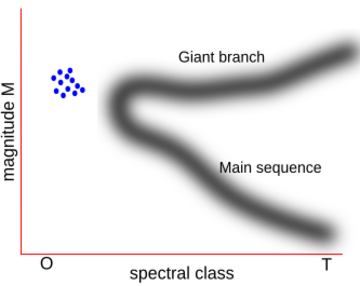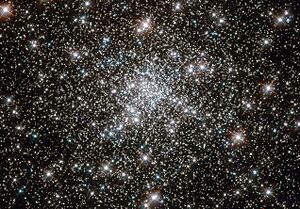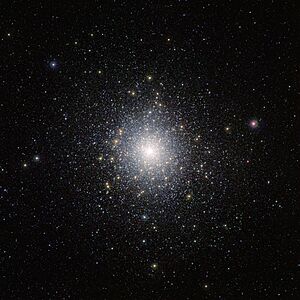Blue straggler facts for kids
A blue straggler is a special type of star that looks much younger and hotter than it should be for its age. Scientists usually find them in large groups of stars called stellar clusters.
In a star cluster, all the stars were born at about the same time. Think of them as siblings. As they get older, they change in predictable ways. But blue stragglers don't follow the rules. They are brighter and bluer than their neighbors, which have already started to age and move towards becoming red giants.
Blue stragglers were first discovered in 1953 by the astronomer Allan Sandage. He was studying the stars in a globular cluster known as M3.
Contents
What Makes Blue Stragglers Different?
According to the science of stellar evolution (how stars change over time), a star's mass and age decide what it looks like. In a star cluster, all stars have the same age. This means they should all line up neatly on a special chart called the Hertzsprung–Russell diagram, which sorts stars by brightness and temperature.
Blue stragglers are the odd ones out. They are much more massive—sometimes two or three times heavier—than the other stars in their cluster. This makes them look like young, hot stars, even though they live in an old star neighborhood.
Scientists believe the answer to this mystery is that blue stragglers are formed by stars getting very close to each other. In the crowded environment of a star cluster, stars can interact in strange ways.
How Are Blue Stragglers Formed?
Scientists have a few exciting ideas to explain how blue stragglers are made. The two most popular theories involve stars interacting with each other.
Theory 1: Star Collisions
One of the main explanations is that blue stragglers are created when two stars crash into each other. In the busy center of a star cluster, stars are packed closely together. Sometimes, two stars can collide and merge to become one single, bigger star.
This new star has more mass than either of the original stars. With its new, heavier mass, it becomes much hotter and shines with a bright blue light, making it look like a brand-new star.
There is good evidence for this idea.
- Blue stragglers are most often found in the dense centers of globular clusters, where collisions are more likely to happen.
- Some blue stragglers spin very fast. One in the 47 Tucanae cluster was seen spinning 75 times faster than our Sun! This is what you would expect from a star formed by a collision.
Theory 2: "Vampire" Stars
Another popular idea involves a pair of stars orbiting each other, called a binary star system. In this pair, one star is usually more massive than the other. The more massive star ages faster. As it gets older, it swells up and some of its outer gas can be pulled away by the gravity of its smaller partner.
The smaller star "steals" mass from the bigger one, almost like a vampire. As it gains this extra material, it becomes heavier, hotter, and bluer, turning into a blue straggler. The star that lost its mass often becomes a small, dim white dwarf.
Scientists have found evidence for this theory, too.
- Some blue stragglers have very little carbon and oxygen on their surface. This suggests their outer layers came from the inside of another star.
- Astronomers using the Kepler space telescope found two blue stragglers that had tiny white dwarf companions, which supports the mass-transfer idea.
In many clusters, like M3 and 47 Tucanae, it seems that both collisions and mass transfers are creating blue stragglers.
Yellow and Red Stragglers
Scientists have also found "yellow stragglers" and "red stragglers." These are stars that are brighter than they should be for their stage of life, but are not as hot as blue stragglers.
These stars might be former blue stragglers that are now starting to age. After their "second youth" as a blue straggler, they begin to cool down and change color, continuing their journey to become giant stars.
See also
- List of Blue straggler stars





